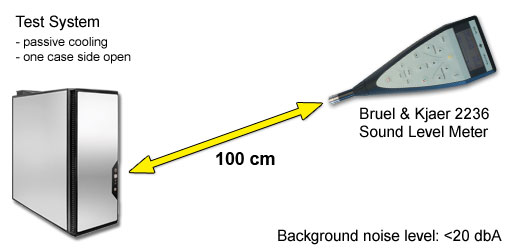 41
41
EVGA GTX 780 Ti Classified 3 GB Review
Performance Summary »Fan Noise
In past years, gamers would accept everything for a little bit more performance. Nowadays, users are more aware of their graphics card's fan noise and power consumption.In order to properly test the fan noise a card emits, we use the Bruel & Kjaer 2236 sound-level meter (~$4,000). It has the measurement range and the accuracy we are looking for.

The tested graphics card was installed in a system that was completely cooled passively. That is, passive PSU, passive CPU cooler, and passive cooling on the motherboard and solid state drive. Noise results of other cards on this page are measurements of the respective reference design.
This setup allows us to eliminate secondary noise sources and test only the video card. To be more compliant with standards like DIN 45635 (we are not claiming to be fully DIN 45635 certified), the measurement was conducted at a distance of 100 cm and 160 cm off the floor. Ambient background noise in the room was well below 20 dBA for all measurements. Please note that the dBA scale is not linear but logarithmic. 40 dBA is not twice as loud as 20 dBA, as a 3 dBA increase results in double the sound pressure. The human hearing perception is a bit different, and it is generally accepted that a 10 dBA increase doubles the perceived sound level. 3D load noise levels were tested with a stressful game, not with Furmark.
Idle fan noise of the EVGA GTX 780 Ti Classified matches that of the NVIDIA GTX 780 Ti reference design - no improvement here despite having a better cooler installed, which is disappointing.
The card is quieter than the NVIDIA board under load, but not by a big margin. I did notice the two fans emitting a whine from time to time (depending on RPM), which appears to be due to air interference. Not much noisier, it is just of a higher frequency, which makes it noticeable. The noise has more of a whoosh-like quality to it once fan speeds change. Still, the card is so much quieter compared to AMD's recent R9 290 Series offerings.
The cooler is running good temperatures of 29°C idle and 75°C load, so making it a bit quieter shouldn't have been hard. My guess is that EVGA focused on low temperatures, which tend to impress overclockers more, because they assume that overclocking will increase their card's temperatures a lot, which is not the case.


Apr 9th, 2025 17:58 EDT
change timezone
Latest GPU Drivers
New Forum Posts
- (omg)vflash | Fully Patched nvflash from X to Ada Lovelace [v5.780] (363)
- 9070XT or 7900XT or 7900XTX (177)
- TPU's Nostalgic Hardware Club (20205)
- [Intel AX1xx/AX2xx/AX4xx/AX16xx/BE2xx/BE17xx] Intel Modded Wi-Fi Driver with Intel® Killer™ Features (308)
- Does anybody know a way to make a scratch on the glass case panel less noticeable or remove it? (19)
- Help me pick a UPS (105)
- ThrottleStop Cache Ratio Fluctuating/Changing Automatically (6)
- 7800X3D and 5070 Ti / 9070 XT Build (2)
- RX 9000 series GPU Owners Club (270)
- I have a bricked XFX Radeon RX 580 8GB GPU. HELP! (26)
Popular Reviews
- The Last Of Us Part 2 Performance Benchmark Review - 30 GPUs Compared
- MCHOSE L7 Pro Review
- UPERFECT UStation Delta Max Review - Two Screens In One
- ASRock Z890 Taichi OCF Review
- Sapphire Radeon RX 9070 XT Pulse Review
- PowerColor Radeon RX 9070 Hellhound Review
- Upcoming Hardware Launches 2025 (Updated Apr 2025)
- Sapphire Radeon RX 9070 XT Nitro+ Review - Beating NVIDIA
- ASUS Prime X870-P Wi-Fi Review
- Acer Predator GM9000 2 TB Review
Controversial News Posts
- NVIDIA GeForce RTX 5060 Ti 16 GB SKU Likely Launching at $499, According to Supply Chain Leak (172)
- MSI Doesn't Plan Radeon RX 9000 Series GPUs, Skips AMD RDNA 4 Generation Entirely (146)
- Microsoft Introduces Copilot for Gaming (124)
- AMD Radeon RX 9070 XT Reportedly Outperforms RTX 5080 Through Undervolting (119)
- NVIDIA Reportedly Prepares GeForce RTX 5060 and RTX 5060 Ti Unveil Tomorrow (115)
- Over 200,000 Sold Radeon RX 9070 and RX 9070 XT GPUs? AMD Says No Number was Given (100)
- Nintendo Confirms That Switch 2 Joy-Cons Will Not Utilize Hall Effect Stick Technology (99)
- Nintendo Switch 2 Launches June 5 at $449.99 with New Hardware and Games (98)
